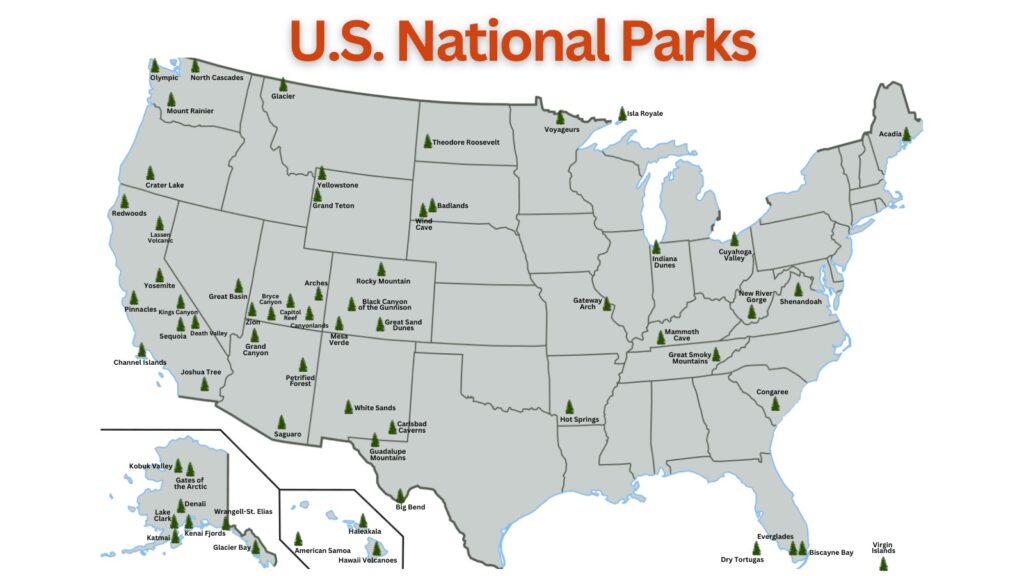How to Plan the Ultimate USA National Parks Tour

The United States is home to some of the world’s most breathtaking natural wonders, and there’s no better way to explore them than by visiting the country’s famous national parks. Whether you’re drawn to the towering peaks of the Rocky Mountains, the expansive deserts of the Southwest, or the lush forests of the Pacific Northwest, the USA’s national parks offer something for every kind of traveler.
Planning a trip to multiple national parks can feel overwhelming, especially if you’re aiming to visit some of the most iconic ones, such as Yellowstone, Yosemite, or the Grand Canyon. To help you plan your adventure, we’ve put together a comprehensive guide to creating the ultimate USA national parks tour. From choosing the right parks to planning your route, here’s everything you need to know.
Step 1: Decide Which National Parks You Want to Visit
The United States boasts 63 national parks, each with its own unique landscapes and experiences. Deciding which ones to visit can be the most exciting and daunting part of your trip planning. Here are a few things to consider when narrowing down your options:
Top National Parks to Consider:
- Yellowstone National Park (Wyoming, Montana, Idaho): The first national park in the world, famous for its geothermal features like Old Faithful and its diverse wildlife.
- Grand Canyon National Park (Arizona): The iconic canyon carved by the Colorado River, offering stunning vistas and numerous hiking trails.
- Yosemite National Park (California): Known for its giant sequoias, dramatic cliffs like El Capitan, and waterfalls such as Yosemite Falls.
- Zion National Park (Utah): A haven for adventurers, with towering sandstone cliffs, slot canyons, and unique hikes like The Narrows.
- Great Smoky Mountains National Park (Tennessee, North Carolina): The most visited national park in the U.S., renowned for its mist-covered mountains and diverse ecosystems.
- Acadia National Park (Maine): A stunning coastal park with rocky shores, forests, and picturesque mountain views.
Consider Your Travel Time:
Do you have weeks or months to explore? Or are you aiming for a shorter, more focused trip? The USA is vast, so it’s important to plan your route carefully based on the time you have. For example, visiting parks in one region (like the Western U.S.) can make your trip more efficient and less tiring.
Seasonality:
Different parks are best experienced at certain times of the year. Some parks, like those in Alaska, are best visited in the summer when roads and services are open. On the other hand, places like the Grand Canyon or Yellowstone can be visited year-round but are most crowded during summer. Consider the season when deciding which parks to include.
Step 2: Plan Your Route
Once you’ve decided on which national parks to visit, the next step is to map out your route. If you’re planning to visit several parks, there are different ways to travel:
Road Trip:
Many national parks are located near each other, especially in regions like the Southwest, Pacific Northwest, and the Rocky Mountains. A road trip allows you to experience the diverse landscapes between parks while maintaining flexibility in your schedule.
- Pro Tip: Rent an RV for a classic American road trip experience! An RV gives you the flexibility to stay within the parks or nearby campgrounds and immerse yourself in the natural beauty.
By Air and Car Rental:
If your parks are spread out across the country, flying between major airports and renting a car to explore the parks may be the most time-efficient method. For example, you could fly into Salt Lake City for Zion, then head to Grand Teton National Park, and finally visit Yellowstone before flying home.
Consider Time Between Parks:
Some national parks are close enough to each other that you can visit several in one trip. However, some of the most famous parks are far apart, requiring long drives or flights in between. Factor in travel times when planning your itinerary.
Step 3: Decide on Accommodation Options
National park accommodations vary greatly, from rustic cabins to luxury lodges, and from remote campgrounds to nearby hotels. Here are the main options:
Camping:
Camping is one of the best ways to fully immerse yourself in the beauty of a national park. Many parks offer well-maintained campgrounds with access to trails, lakes, and wildlife. Some parks, like Yellowstone and Yosemite, even offer backcountry camping for more adventurous travelers.
- Pro Tip: If you’re visiting during peak season, be sure to reserve your campsite months in advance, as they often fill up quickly.
Lodging Inside the Parks:
Some parks offer lodges or cabins within their boundaries, allowing you to wake up to stunning views and be close to popular trails. Yosemite’s Ahwahnee Hotel and Yellowstone’s Old Faithful Inn are two examples of famous in-park lodgings. Staying inside the park can save you time and provide easy access to scenic spots.
Nearby Hotels or Rentals:
If you prefer more comfort or don’t want to camp, consider staying in nearby towns or booking vacation rentals. Many national parks have nearby towns with various options for lodging, dining, and activities.
Step 4: Plan Activities and Experiences
National parks offer a wide range of activities, from hiking and wildlife watching to stargazing and scenic drives. The experiences available depend on the park and the season, so plan ahead to make the most of your time.
Hiking:
Most national parks have well-marked hiking trails, ranging from short, easy walks to challenging multi-day treks. Some of the most iconic hikes include:
- Half Dome in Yosemite
- The Narrows in Zion
- Bright Angel Trail at the Grand Canyon
Wildlife Watching:
Many parks offer unique wildlife viewing opportunities. Yellowstone is known for its bison, elk, and bears, while Great Smoky Mountains is home to diverse species like black bears and salamanders.
Scenic Drives:
If you’re short on time or want a relaxing way to see the park, many national parks have scenic drives, such as the Going-to-the-Sun Road in Glacier National Park or the South Rim Drive in Grand Canyon National Park.
Ranger Programs:
Check out ranger-led programs to learn more about the park’s natural and cultural history. Many parks offer evening campfire talks, guided hikes, or educational exhibits.
Step 5: Prepare for the Adventure
Now that you’ve planned your route, activities, and accommodations, it’s time to prepare for your adventure! Here are some tips to ensure you’re ready for the journey:
Packing Essentials:
- Clothing: Pack for the weather, but be prepared for quick changes in temperature. Even in summer, mornings and evenings can be chilly, especially in mountainous areas.
- Hiking Gear: Comfortable shoes, a daypack, sunscreen, a hat, and plenty of water.
- Emergency Essentials: A first-aid kit, maps, a flashlight, and extra batteries.
Health and Safety:
- Altitude: If you’re visiting high-altitude parks like Rocky Mountain National Park, take it easy for the first couple of days to avoid altitude sickness.
- Wildlife: Keep a safe distance from animals and follow all park guidelines to ensure both your safety and the animals’.
- Weather: Be aware of the weather conditions, as they can change rapidly. Some parks experience snow even in the summer, so check forecasts ahead of time.
Step 6: Respect the Parks and Leave No Trace
Finally, it’s important to remember that national parks are protected areas. Respect the rules, wildlife, and natural surroundings. Follow the Leave No Trace principles to minimize your impact and help preserve these parks for future generations.
Conclusion: Ready to Hit the Road?
Planning the ultimate USA national parks tour is an exciting and rewarding adventure. With careful planning, you can experience some of the most stunning landscapes in the world and create memories that will last a lifetime. Whether you choose to explore a few select parks or embark on a cross-country road trip, make sure to take your time, soak in the beauty of the natural world, and most importantly—enjoy every moment!




